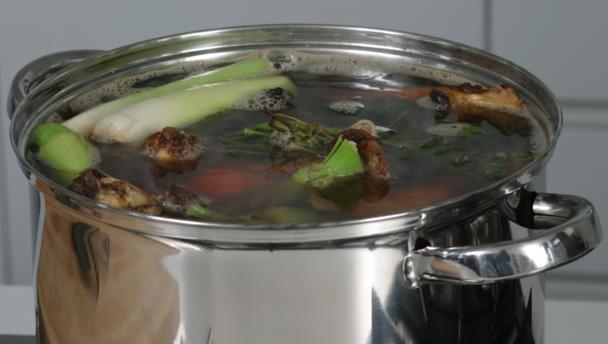

By Mike Robinson
A flavoured liquid base for making a sauce, stew or braised dish, made by simmering beef, chicken or fish with vegetables, aromatic ingredients and water. Vegetable stock is made exclusively with vegetables. Meat stocks are boiled for several hours to extract collagen and gelatine from the bones, giving a silky texture to sauces. Fish and vegetable stocks will not produce this effect, and should be cooked for a shorter time to ensure the flavour is kept light and fresh.
Fresh stock can be substituted with stock cubes and stock powders, whose main ingredients are herbs and spices, yeast extract, caramel, sugar, salt, onion, celery, fat and monosodium glutamate (MSG).
See all recipes for stock (4)
 Seychelles fish curry
Seychelles fish curry
 Sweet onions with lentil stew
Sweet onions with lentil stew
 Beans on toast
Beans on toast
 Coronation prawn vol-au-vents
Coronation prawn vol-au-vents
 Potted salmon
Potted salmon
 Thyme-buttered cabbage
Thyme-buttered cabbage
 Stir-fried corn and chilli
Stir-fried corn and chilli
 Traditional gravy
Traditional gravy
Many varieties of ready-made fresh stocks, stock cubes and powders can be bought from most supermarkets. If you want to avoid MSG, check the product ingredients before you buy, as there are some powders and cubes that are made without it.
When meat stock is made with plenty of bones it sets on cooling to a jelly that can be stored in the fridge for up to five days. Alternatively, meat stocks can be reduced after straining to a very condensed liquid which can then be cooled and frozen in individual portions in ice cube trays. Thinner homemade stocks, including vegetable and fish stocks, should be cooled quickly (within 90 minutes) and stored, covered, in the fridge for up to three days. However, unless you're certain of using the stock quickly, it's generally better to make a large batch and store it in convenient portions in the freezer, where it will keep for three months.
Trimmings, scraps, vegetable peelings and herb stalks can all be incorporated in stocks but remember that the stockpot is not a substitute for the bin: ingredients should still be of good quality and clean. If you want to intensify the flavour of meat or poultry stock, use more bones, giblets and trimmings rather than trying to simmer the ingredients for a longer period. Never let stocks boil hard as this will make any fat in the ingredients emulsify, giving a cloudy appearance and greasy taste - instead cook at a gentle simmer. Skimming the fat and froth that forms on top of the simmering stock is essential to achieve a clear result. Once the stock has been strained and the solids discarded, the liquid should be skimmed again. A well-made stock should be delicious enough to drink on its own.
Be cautious with your seasoning when cooking with stock cubes and powders instead of fresh stock because they can be quite salty.
Type the ingredients you want to use, then click Go. For better results you can use quotation marks around phrases (e.g. "chicken breast"). Alternatively you can search by chef, programme, cuisine, diet, or dish (e.g. Lasagne).